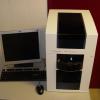Study of enzymatic reaction by capillary electrophoresis
Studies of enzyme reaction by CE, which have been under active investigation in recent years [1], include i) enzyme reaction prior CE analysis; ii) enzyme reaction during CE analysis also known as electrophoretically mediated microanalysis (EMMA) and iii) application of immobilized enzyme reactor (IMER). Among them the EMMA and IMER based methods have shown a high degree of versatility and attracted most research attentions, because of low detection limits, short analysis times and automation.
EMMA utilizes differential electrophoretic mobilities of enzyme and substrate(s) that are introduced in the capillary as distinct plugs, the first analyte injected being the one with the lower electrophoretic mobility. After the application of an electric field, the two zones interpenetrate due the differences in their electrophoretic mobilities. Enzyme reaction takes place and the resultant reaction product and the unreacted substrate are electrophoretically transported towards detector, where they are individually detected.
Although the first reported IMER were prepared almost 100 years ago, their revival occurred in the past decade and a significant increase in the number of reports describing their preparation and use can be observed even in combination with CE. One of the most important domains of IMER is protein digestion in proteomic research. In addition, the application of bioreactors containing immobilized enzymes is also growing in biotechnology, chemical synthesis, and the pharmaceutical industry, where these reactors enable rapid screening of enzyme inhibitor candidates as well as detailed characterization of binding interactions and reaction mechanism.
All these CE modification will be used in this project for the study of biotechnologically and pharmaceutically important enzymes. Like in the case of ACE the microchip format will be tested as well.
References:
[1.] Glatz, Z., Determination of enzymatic activity by capillary electrophoresis. J. Chromatogr. B 2006, 841, 23-37.


